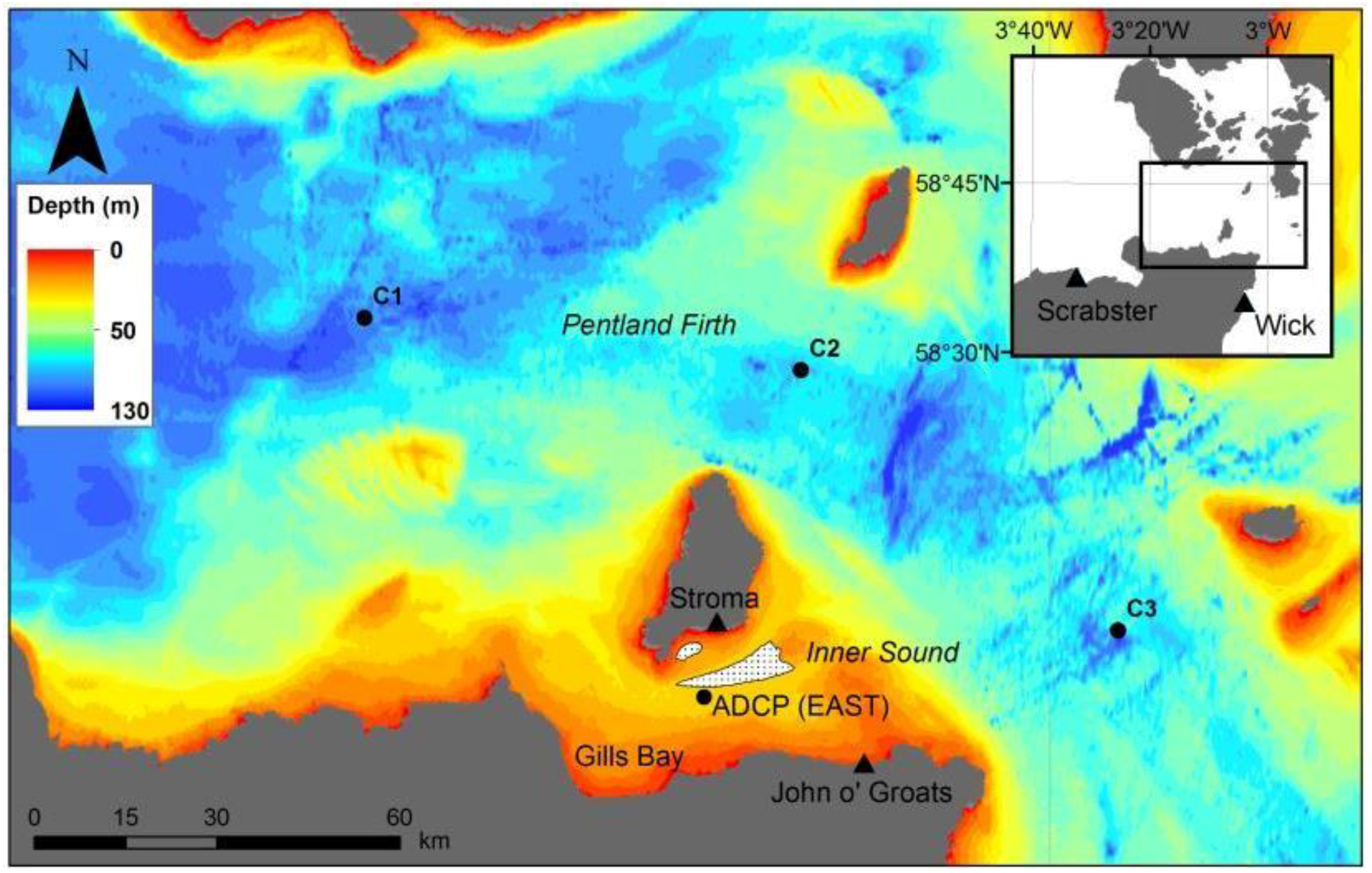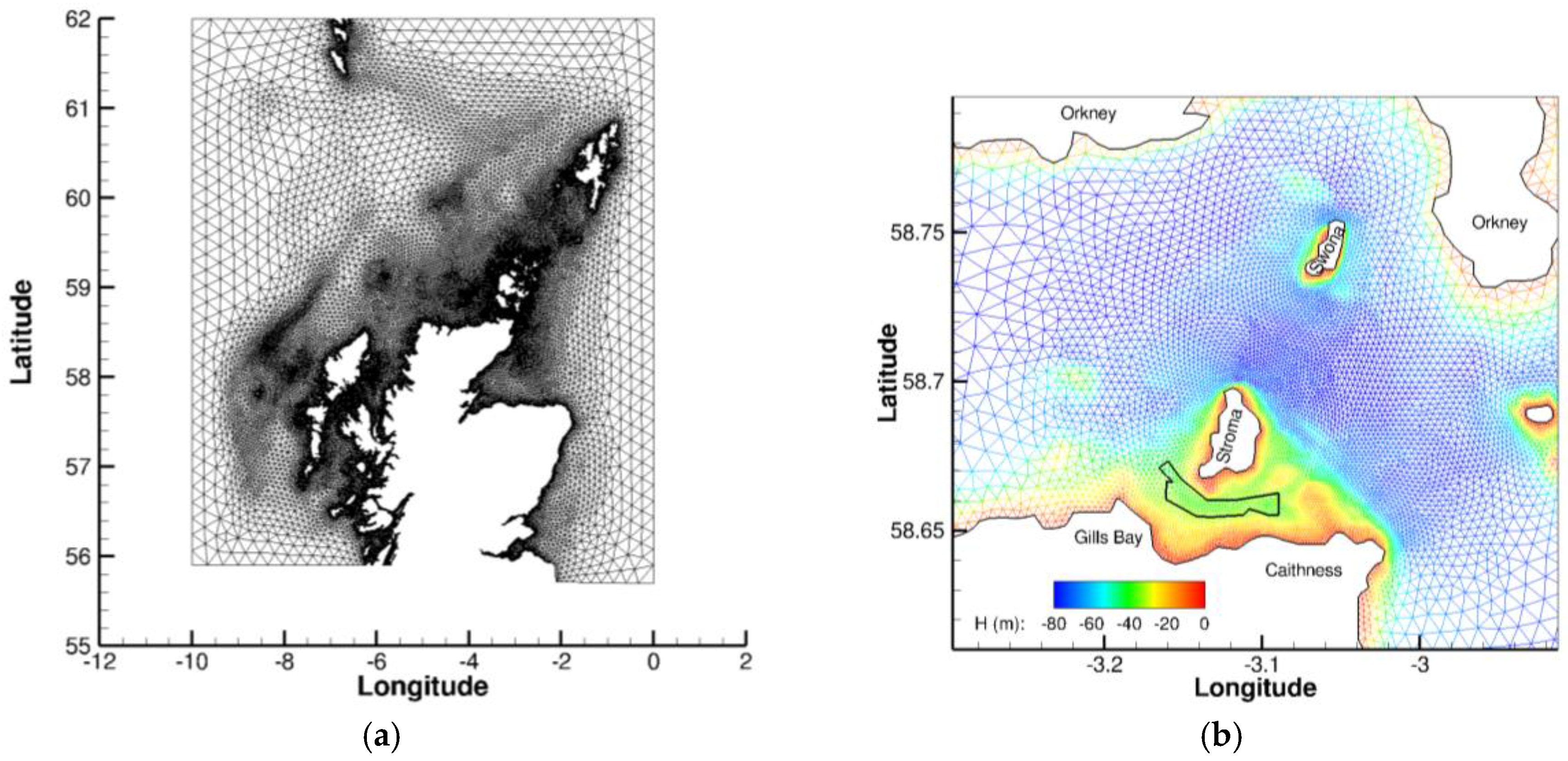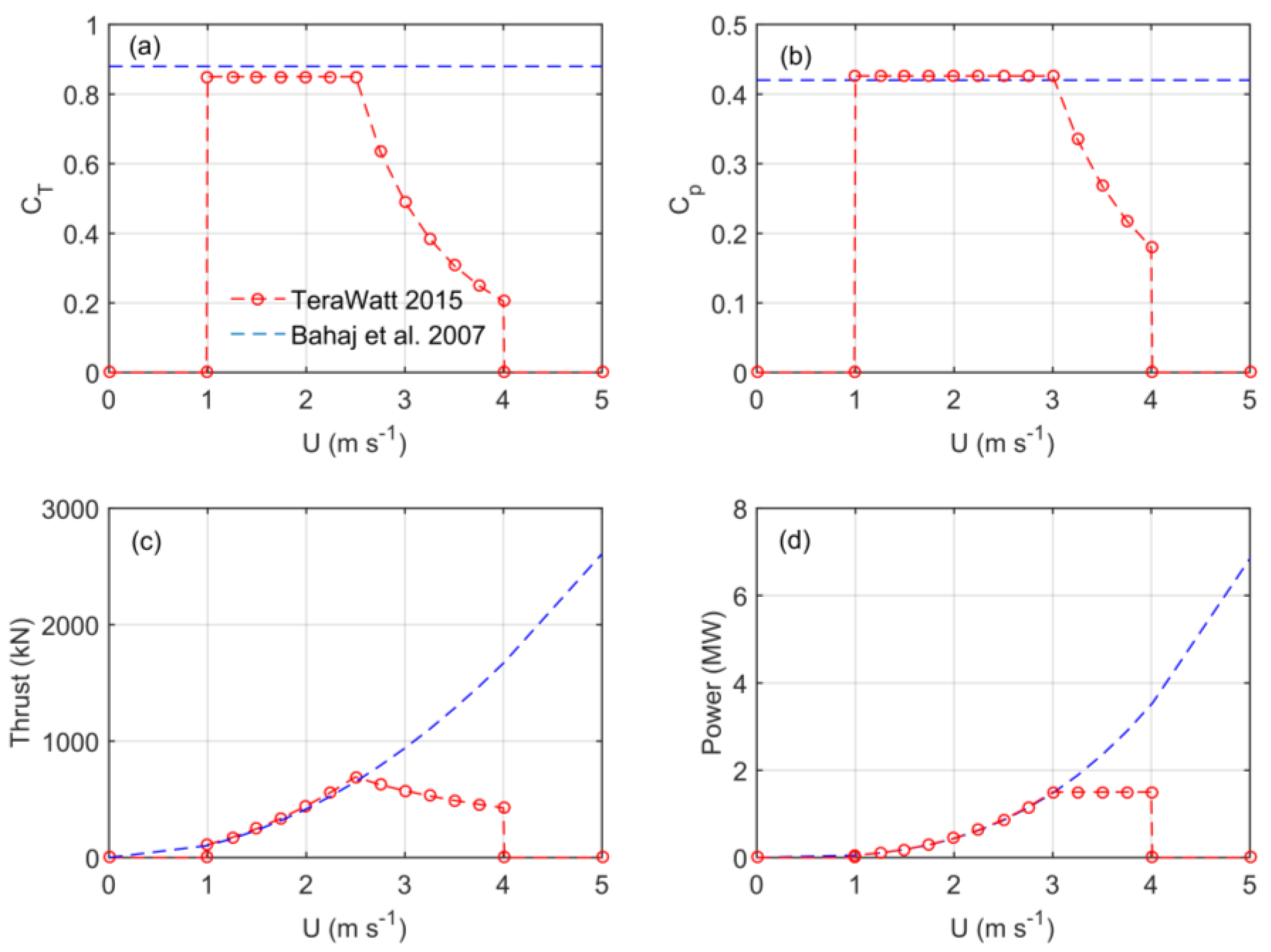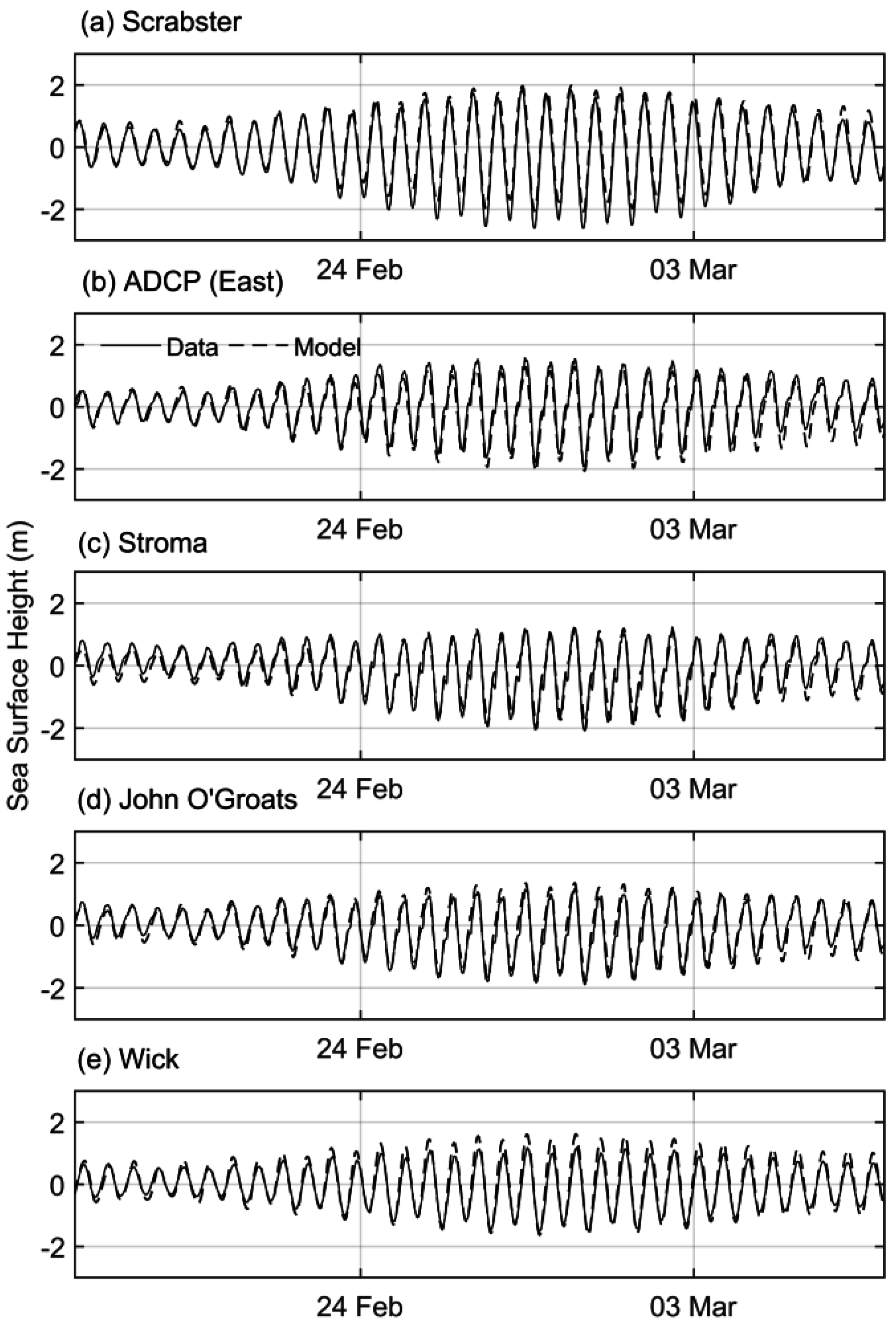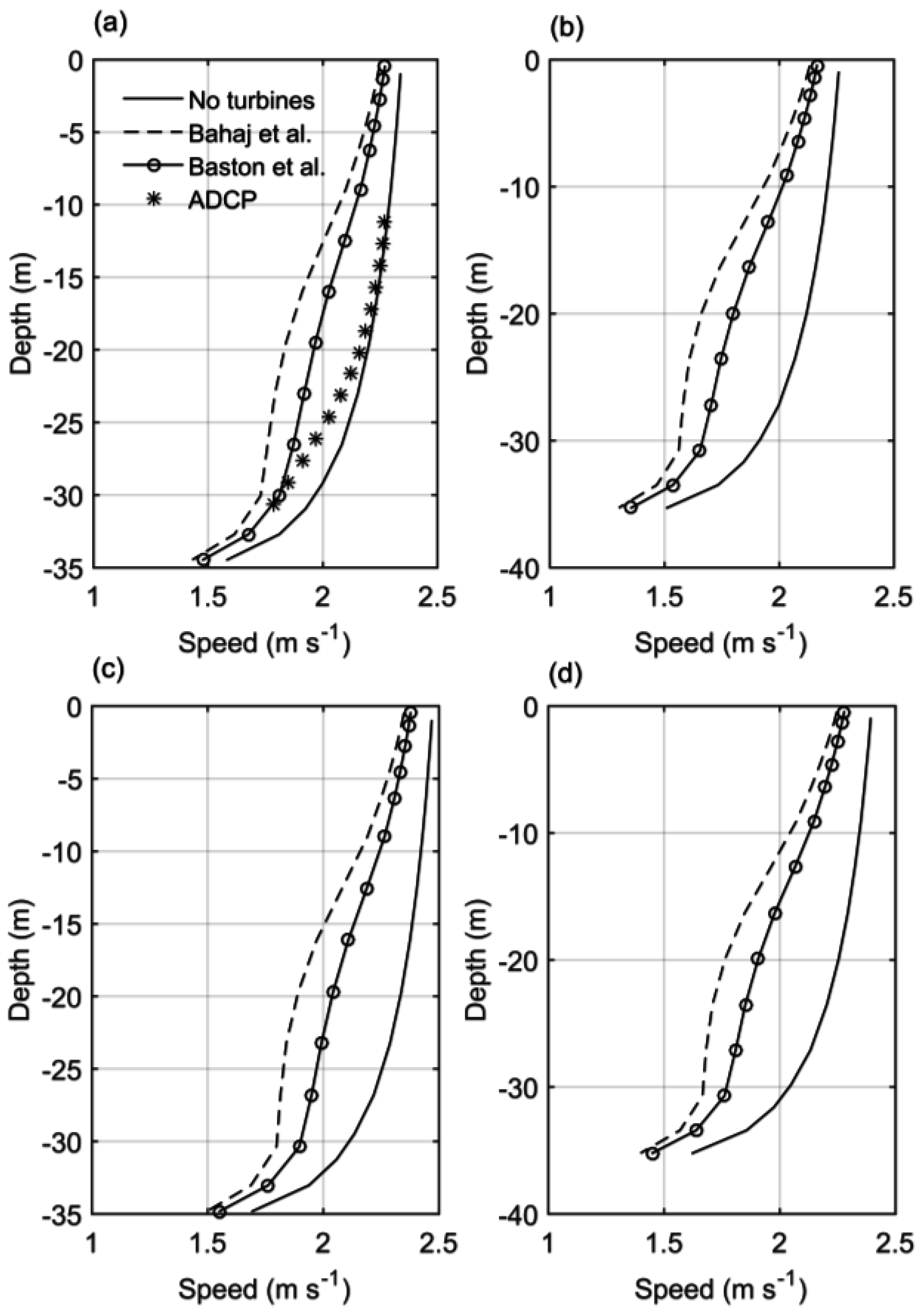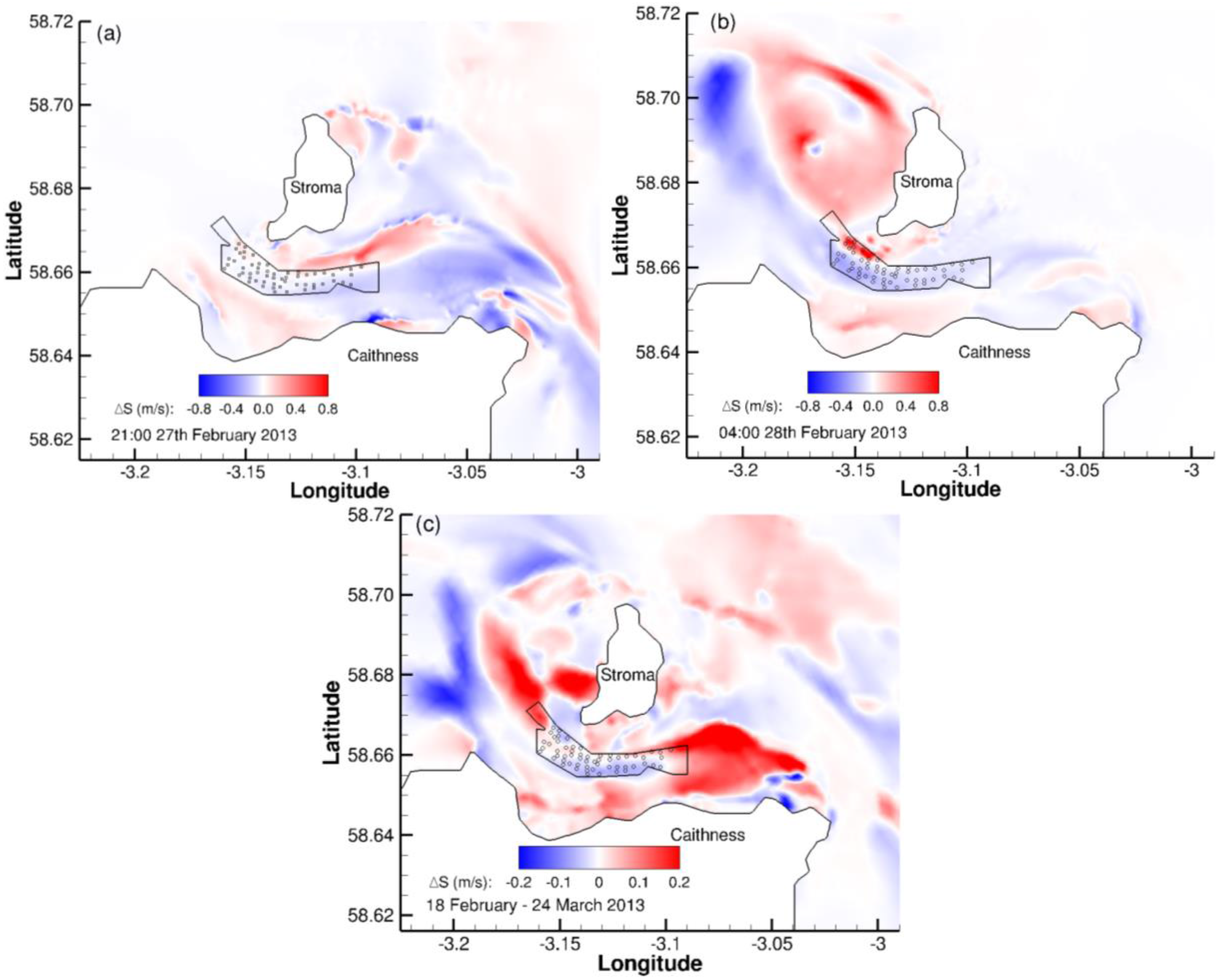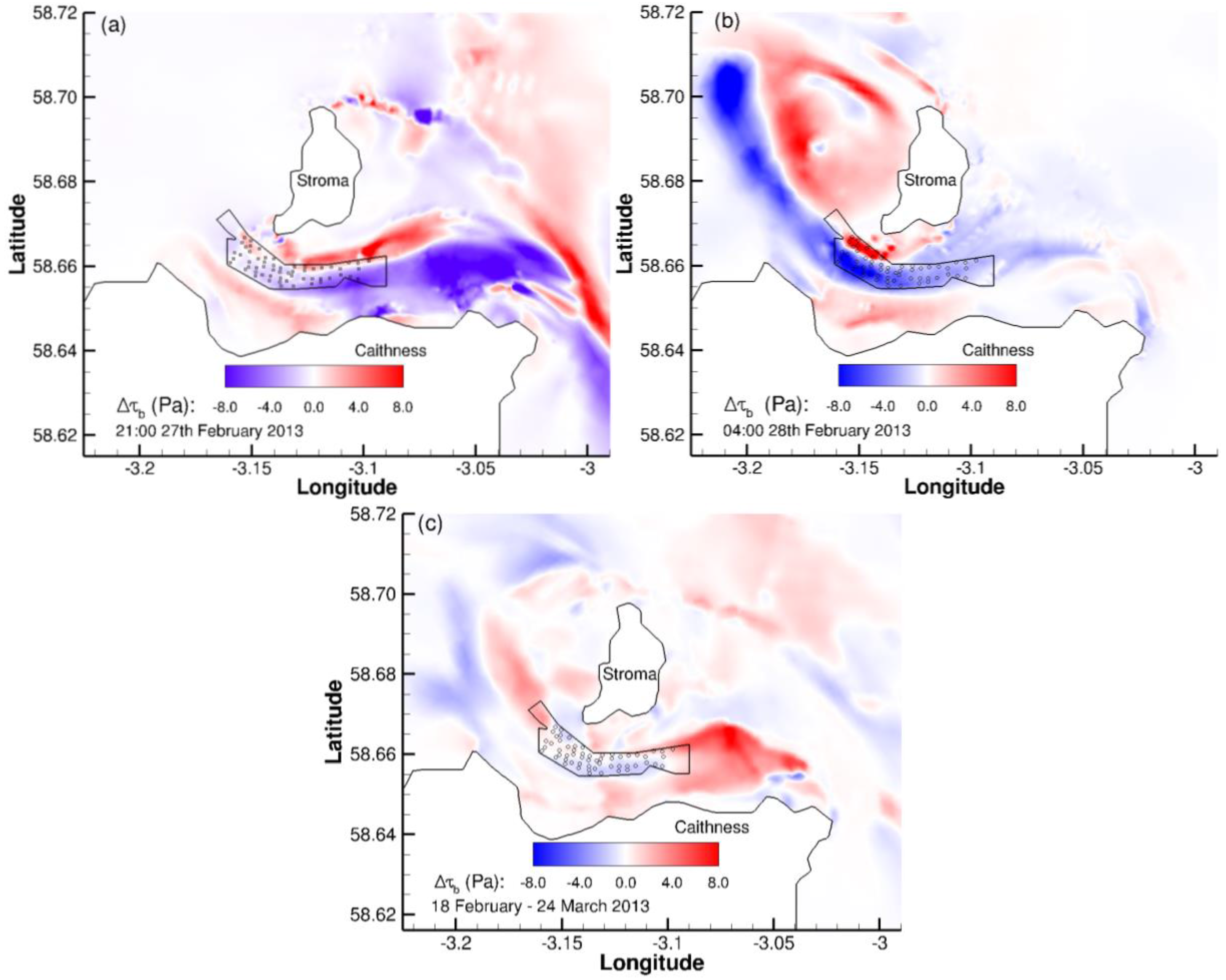1. Introduction
Over the past decade, the strong tidal flows in a number of regions around the world have been a focus of attention for tidal energy developers, with sites identified and leases granted for tidal energy extraction using tidal turbines. One of the primary areas of interest has been the Pentland Firth in the north of Scotland, which connects the North Sea and the North Atlantic and through which tidal current speeds regularly reach 5 m·s
−1. The tidal energy potential for the whole Firth has been estimated to be in the range of 1–18 GW [
1], though Adcock et al. [
2] suggest that a more realistic figure for the maximum available power is 1.9 GW. At the time of writing, the Meygen tidal turbine array, planned for the Inner Sound channel of the Firth, is among the first commercial tidal energy arrays to be installed anywhere in the world. Tidal current speeds in the Inner Sound have been recorded at up to 6 m·s
−1 during flood spring tides, offering an energy resource of up to 398 MW to the Meygen project [
3].
Consent to deploy tidal turbines is generally subject to environmental impact assessment, with a requirement to demonstrate environmental effects within acceptable limits. Currently, these assessments typically focus on collision risk for marine mammals and seabirds, which present the highest impact risks. However, other, more subtle, environmental impacts arising from the deployment of large numbers of tidal turbines can be envisaged. These have been outlined by a number of authors, with the focus being mainly on ecological and socio-economic impacts (e.g., [
4,
5]).
One of the potential impacts of tidal energy is on sediment transport and the effect of energy extraction on the movement of sediment through these energetic channels. An early study by Neill et al. [
6] demonstrated that installations of tidal energy convertors in the Bristol Channel (south-west UK) could influence large scale sediment dynamics and bed level changes. In a subsequent study, Neill et al. [
7] found that tidal turbines could also impact sand bank formation and evolution near headlands. In the Pentland Firth, Martin-Short et al. [
8] used a high resolution hydrodynamic model to identify areas of sediment erosion and deposition, based on critical bed shear stress distributions calculated by the model. They found that installing arrays of more than 85 tidal turbines in the Inner Sound had the potential to significantly displace areas of sediment accumulation from the sides of the channel towards the centre, as the flow was diverted around the array. With still larger arrays of more than 240 turbines, beds of larger sized sediments, such as fine gravel and coarse sand, were also predicted to migrate towards the channel centre. Their study, however, was undertaken using a two-dimensional, depth-averaged model, which cannot resolve the specific near-bed velocity relevant for sediment transport processes; in particular, the potential exists for flow to be accelerated
beneath tidal turbines, as well as around the sides, and this process clearly cannot be simulated with a depth-averaged model. A further study using a three-dimensional (3D) model, by Fairley et al. [
9], extended the modelled sediment transport in the Pentland Firth into predictions of bed level changes, and again investigated the possible effects of turbines deployed in the Inner Sound on sediment deposition and erosion. They found that currently proposed arrays would have only minimal effect on the baseline morphodynamics of the large sandbanks in the region, but did not consider the smaller sandbanks local to the arrays. A further consideration is that changes to sediment deposition and erosion patterns are likely to have knock-on effects on benthic communities that rely on suspended organic material. Harendza [
10] found that bed shear stress was closely associated to the composition and distribution of benthic assemblages in the Inner Sound, and developed site-specific habitat suitability models based on physical characteristics both in the absence and presence of tidal turbines.
Martin-Short et al. [
8] and Fairley et al. [
9] both noted that accurate sediment modelling is inhibited by a lack of detailed knowledge of local sediment deposits and transport in the area. Fairley et al. [
9] combined a variety of data to construct a map of sediment type through the Pentland Firth and surrounding area, but detail in the Inner Sound was limited. Information on local sediment distributions in the Inner Sound is gradually being accumulated through multibeam [
3] and sidescan sonar surveys [
11,
12]. Sediment banks are known to lie to the south of the island of Stroma (
Figure 1) but the local sediment dynamics, and the potential impacts of tidal energy extraction on the deposits, are only beginning to be understood. McIlvenny et al. [
11] suggested that the local sediment banks in the Inner Sound (
Figure 1) have been locked in place for a significant period of time, with rates of sediment erosion and deposition expected to be low over the period. The tidal current velocities and the bed shear stress fields calculated by McIlvenny et al. [
11] using a 2D hydrodynamic model were largely consistent with the observed sediment distributions, with sediment banks lying adjacent to the main flow through the Inner Sound. However, as with [
8], the depth-averaged modelled velocities used by McIlvenny et al. [
11] cannot be considered ideal to calculate bed shear stress fields.
Understanding of the tidal flow through the Pentland Firth and its subsidiary channels has advanced in recent years, due in part to the proliferation of numerical (e.g., [
1,
2,
8,
9,
13], etc.) and observational studies (e.g., [
14]). The strong flows through the Firth are generated from the hydraulic pressure head that forms across the channel due to the restriction placed on the propagation of the tide [
13]; in order to capture the forcing of the flow through the Firth, it is necessary to accurately simulate the regional tidal regime. Most of the previous modelling studies have focused on the flow through the wider Pentland Firth, whereas in this paper we specifically consider the flow through the Inner Sound. The development of accurate and robust hydrodynamic models of the region is particularly important at present in order to predict potential effects on the ambient environment of tidal energy extraction prior to the deployment of large scale arrays.
In this paper, we investigate the potential effects of the development of a tidal turbine array on the bed shear stress in a tidally energetic channel: the Inner Sound of the Pentland Firth. Bed shear stress is a key parameter in the erosion of seabed sediment, and understanding potential implications of tidal energy developments on local sediment dynamics requires first an estimate of possible changes to the bed shear stress. Building on the 2D modelling work reported by McIlvenny et al. [
11], we extend the modelling study to three dimensions, thereby resolving the vertical structure of the flow; we expect this to improve the estimates of near-bed velocity and therefore local bed shear stress during flood and ebb tides, and to allow better predictions of the potential changes to bed shear stress following the installation of tidal turbines in the region. In the following sections, we briefly describe the formulation of the model, including the parameterization of tidal turbines, and verify its performance against observations of sea surface height (SSH) and tidal current velocity. Results from simulations examining the effects of tidal turbines on velocity profiles, near-bed velocity fields and local bed shear stress are then presented. In the final sections, the results are discussed and some conclusions drawn.
3. Model Calibration and Evaluation
The hydrodynamic model accurately reproduced the tide at tide gauge locations around the northern Scotland coastline, including both ends of the Pentland Firth, capturing the change in amplitude and phase of the tide that occurs through the Firth (
Figure 5). This is a minimum requirement for the model to be fit-for-purpose, since currents in the Firth are largely driven by sea level pressure gradients [
13]. We varied the frictional drag coefficient,
CD, over an order of magnitude range, 0.002 ≤
CD ≤ 0.01. Overall, the best agreement was achieved with mid-range values, although no single value produced the best results at all locations. The model results reported in the remainder of this paper are from the simulation with
CD = 0.004, similar to values used in other studies (e.g., [
13]).
Tidal analysis confirmed that the modelled amplitudes of the dominant M
2 constituent were typically within ±0.04 m (<5%) of the observed values, with the exception of John O’Groats, where the discrepancy was 0.10 m (
Table 4). Modelled phases for the M
2 tide were within 3° of the observed values at all locations. The model captured the sharp change in M
2 phase across the Pentland Firth.
For the smaller constituents, model-data discrepancies in both amplitude and phase were slightly larger as the errors in the tidal analysis increased due to the relatively short time series (34 days). Errors in the amplitude of the S2 tide were generally less than 0.03 m, except against the ADCP measurements, and errors in the S2 phase were less than 10°. For N2 and the diurnal constituents, the modelled amplitude was within 0.04 m and the modelled phase generally within 10° of the observed values. Interestingly, the discrepancies in the modelled phases of the K1 constituent at Stroma and the ADCP location (both within the Inner Sound) were larger, although good agreement was achieved at the surrounding locations.
Calibration of the model was based on SSH, with the performance of the model with the selected value of
CD = 0.004 then assessed by comparing the modelled velocities against moored ADCP data. The comparison showed acceptable levels of agreement in the magnitudes and phases of velocity for the principal tidal constituents (
Table 5), particularly given the uncertainties in the Gardline ADCP data from the Pentland Firth. The M
2 tidal constituent dominated both the regional tides and particularly the local tidal currents in the Inner Sound, being 2.5 times stronger than the next largest constituent S
2 (
Table 5). Errors in the amplitude of the dominant East component of the M
2 constituent were of the order of 20% of the observed amplitudes. For the Inner Sound ADCP data, however, the quality of which is more certain, the model error was less than 5% of the observed amplitude. This is important since our focus in this paper is on the Inner Sound. In terms of phase for the eastward M
2 velocity, the modelled tide led the data by 6° at the Inner Sound ADCP; the average difference between model and observations over all sites including the Gardline data was 4° (
Table 5). This is very good agreement for the dominant tidal component.
For the northward component of M2 velocity, relative errors were larger since the amplitude of the component is much smaller than the eastward velocity. In particular, at C1 and the ADCP location, the amplitudes of the northward component were only about 5% of the eastward component. The model performed better at C2 and C3, where the amplitude of the northward component is comparable to the eastward. The modelled phases also compared much better at C2 and C3. The flow through the Pentland Firth, and through the Inner Sound in particular, is highly dynamic, turbulent, and strongly steered by local topography. The high spatial variability in the flow makes comparison between modelled and predicted currents difficult, particularly in the cross-flow direction; in these regions of highly sheared flow, small changes in location of the model output can substantially affect the error estimate. We have not, therefore, placed a strong emphasis on the northward component of velocity in the calibration exercise.
For the smaller S
2 constituent, average modelled errors were larger than for M
2, with average modelled amplitude errors of 26% of the observed amplitude. The phase of the eastward S
2 constituent had an average error of 9° (
Table 6), and only 3° in the Inner Sound. Like the M
2 constituent, the northward component of S
2 had large relative errors for the small amplitude tide, and larger errors in phase at C1 and C3; the S
2 phase at C2 and the Inner Sound were modelled reasonably well.
Given the good model performance for SSH and the uncertainty in the observed current data, the model performance is acceptable. Further refinement of the model is expected as more observational data, from additional ADCP deployments and surveys and deployment of an X-band radar system, become available.
5. Discussion
Ongoing concerns about possible environmental effects of large arrays of tidal turbines on the marine environment and ecosystem need to be addressed in order to ensure that the fledgling marine renewable energy industry can develop and meet its potential in a sustainable manner. The current absence of real world commercial tidal arrays means that accurate and robust hydrodynamic models are an important tool to predict potential effects on the ambient environment prior to array development. Here we have explored the performance of a three-dimensional hydrodynamic model that uses finite element solution techniques on an unstructured grid to simulate tidal flows and turbine impacts through the Pentland Firth and Inner Sound, where tidal energy capacity is being actively developed [
3]. The model reproduced the amplitude and phase of the surface tide accurately, capturing the change of both that occurs through the Pentland Firth. The agreement between modelled M
2 currents was generally very good, particularly for the predominant eastward component. Errors tended to be larger for the comparison with the currents at C1; it is possible that the reported “knock down” of the mooring [
9,
17] was more of an issue at this site. However, the phase of the M
2 current was very well modelled at all sites. Errors for the eastward component of the S
2 tide were larger than for M
2, although the phase was again accurately reproduced. The larger errors occur as the amplitude of the constituent is a much smaller component of the total signal, making the constituent harder to model. Again, the errors for site C1 were larger than at the other sites, raising questions over the reliability of the data at that location.
The northward components of both constituents were not as accurately reproduced as the eastward components, being generally significantly smaller in amplitude. In the Inner Sound, for example, amplitudes of the northward components were only about 13% of the eastward amplitude. The high spatial variability of the flows may also disproportionately affect the northward components in the model-data comparison. Overall, the calibration exercise demonstrated that the key elements of tidal flow through the region were well captured by the model.
The calibration exercise found that simulations with a drag coefficient of
CD = 0.004 produced the overall best fit to the observations. This value is consistent with values used in other numerical studies of this area (e.g., [
2,
8,
9,
13]). However, the model was not highly sensitive to the drag coefficient used, with values in the range 0.003 ≤
CD ≤ 0.006 all resulting in acceptable model performance, accurately simulating the change in tidal amplitude and phase across the Firth.
The ability of the model to simulate tidal turbine effects using a form drag approach has been demonstrated previously [
26,
33], and the model has been applied in other locations to estimate potential marine energy generation [
24,
25]. Form drag from subgrid objects must be dealt with by integral methods to connect the subgrid scale with the model scale [
26], but clearly, subgrid scale effects cannot be reproduced with this method. Other approaches to modelling tidal turbines in ocean models have been used (e.g., [
2]). Each approach poses challenges in terms of the choice of velocity used to calculate both the thrust imposed by the turbine on the flow and power generated. Actuator disc theory requires detailed information of the flow upstream from, downstream from and at the turbine location. The last of those is hard to obtain from an ocean model with, typically, much larger grid cell size than the scale of a turbine. The form drag approach, likewise, requires an approximation of local free-stream velocity in order to calculate thrust and power using (6) and (7), the specification of which is not obvious in complex real world tidal flows. Walters [
26] tested three approaches to addressing the discrepancy between reference and volume-averaged velocity, one iterative method and two mapping formulations (one from [
34]), and achieved similar estimates of thrust and power generation with each. For larger turbine arrays, the iterative approach is less attractive, but the mapping formulations appear to offer a promising solution to the problem. The approach employed here, using a relatively large averaging volume at the turbine location such that the averaged flow approximated the reference velocity, worked reasonably well and gave satisfactory results for power generation. However, future work will include testing of the mapping formulations to improve the representation of turbine drag in the model.
In the simulations reported here, the mean power generated per turbine fell as the size of the array became larger (
Figure 10) as evidently the blocking effects of the array itself inhibited power generation at down turbines. The turbines modelled here were located arbitrarily with the lease area since likely locations are not known. Because the model does not reproduce the sub-grid scale details of turbine wakes, the power estimates were based on an implicit assumption that interactions between individual turbines were weak. The turbines were positioned at least a blade diameter apart and were not aligned, which should minimize wake effects. Dealing with wake effects in coastal ocean models (rather than CFD codes) is a matter of ongoing research. Array optimization has been the subject of considerable analytical and theoretical work (see [
39] for a review), but less work through numerical modelling. Recent developments include the use of adjoint methods with a 2D model to optimize the locations of 256 turbines in a channel with steady flow [
40]. That study found a solution for the optimal positions of the 256 turbines within 200 forward runs. An alternative approach is too simply run successive iterations of a numerical model, placing turbines iteratively at the location of highest velocity within the array area until the full array is position. For large arrays, such iterative solutions to find the best locations appear to present daunting computational demands, but the present model is fast and simplified 2D solutions could be attempted using this approach.
Deploying increasing numbers of turbines in the water column clearly proportionately modifies the ambient hydrodynamics. The effects of the small numbers of turbines (e.g., single turbines and a group of 4) modelled here were small; however, the larger array of 57 turbines produced some clear impacts on near-bed velocity and bed shear stress, not just at the location of the turbine array but over the local area for several kilometres. The enhanced stress predicted is enough to have significant effects on sediment type and is coincident with an established shell bank [
11]. The shell fragments comprising the bank are not spherical but rather flat, and their depositional and erosional characteristics are not currently well known [
11], so the effects of an increase in bed shear stress by up to 8 Pa is difficult to predict at present. However, ongoing monitoring of the shell bank [
12] will provide valuable data for future modelling of similar banks in the region as tidal energy deployments proceed.
This zone of enhanced bed stress was not captured by modelling studies by Martin-Short et al. [
8] and Fairley et al. [
9], but otherwise our results were broadly consistent with theirs. Within and downstream of the array, velocities were reduced and broad bands of reduced bed stress extended downstream. Martin-Short et al. [
8] modelled the impacts of an array of 400 turbines and found bed shear stress changes of up to 25 Pa, peaking to the east of the array above the shallow ridge. They used a 2D model, whereas it is evident from the profiles of velocity that near-bed velocity is significantly reduced relative to the depth-averaged, and a 3D model is necessary to accurately predict bed stress. They found changes to the velocity field and bed shear stress extended up to 15 km from the array location, but their array of 400 hundred turbines extracted about five times more energy than our simulated array.
In contrast to the shell bank, the location of the oval-shaped sand bank in the bay on the southern shore of Stroma (
Figure 1) was not predicted to experience significant changes to bed shear stress due to array development. The predicted values of Δ
τb above the sand bank were less than 1 Pa (
Figure 10), which should have minimal impact. Monitoring both the sand and shell banks into the future could provide an interesting contrast in the influence of the array on local sediment features.
Fairley et al. [
9] focused on two regions of sandy seabed in the vicinity of the Pentland Firth, one of which was the area of sandbanks found to the west of Stroma. These sandbanks consist of medium to coarse sand [
9]. They modelled changes to bed level (i.e., seabed sediment thickness) using the DHI MIKE3 FM modelling package and found, firstly, that the area is quite dynamic and that the bed level changed by up to 5 m over a one-month simulation, and secondly, that this change was modified by up to 4% by deployment of turbines in the Pentland Firth. Our results also indicated the potential for noticeable changes to the hydrodynamic regime to the west of Stroma caused by the deployment of an array in the Inner Sound. The predicted change in bed shear stress above these sand banks of up to ±8 Pa could erode some of these sediments, introducing a shift from sand to gravel in some locations and allowing finer sand to settle in others. These results, together with those of [
9], suggest that monitoring of the sediments to the west of Stroma will be a worthwhile study as turbines are deployed in the Inner Sound.
